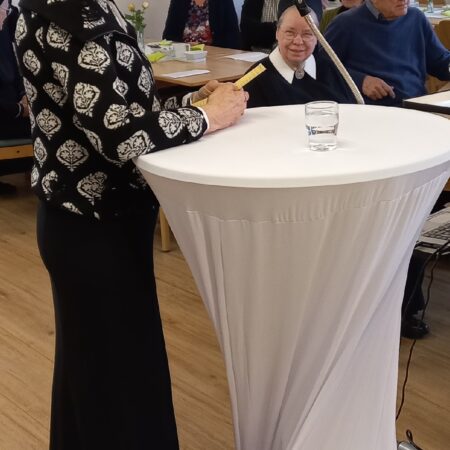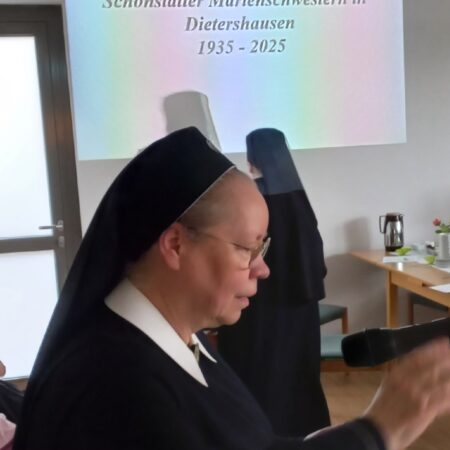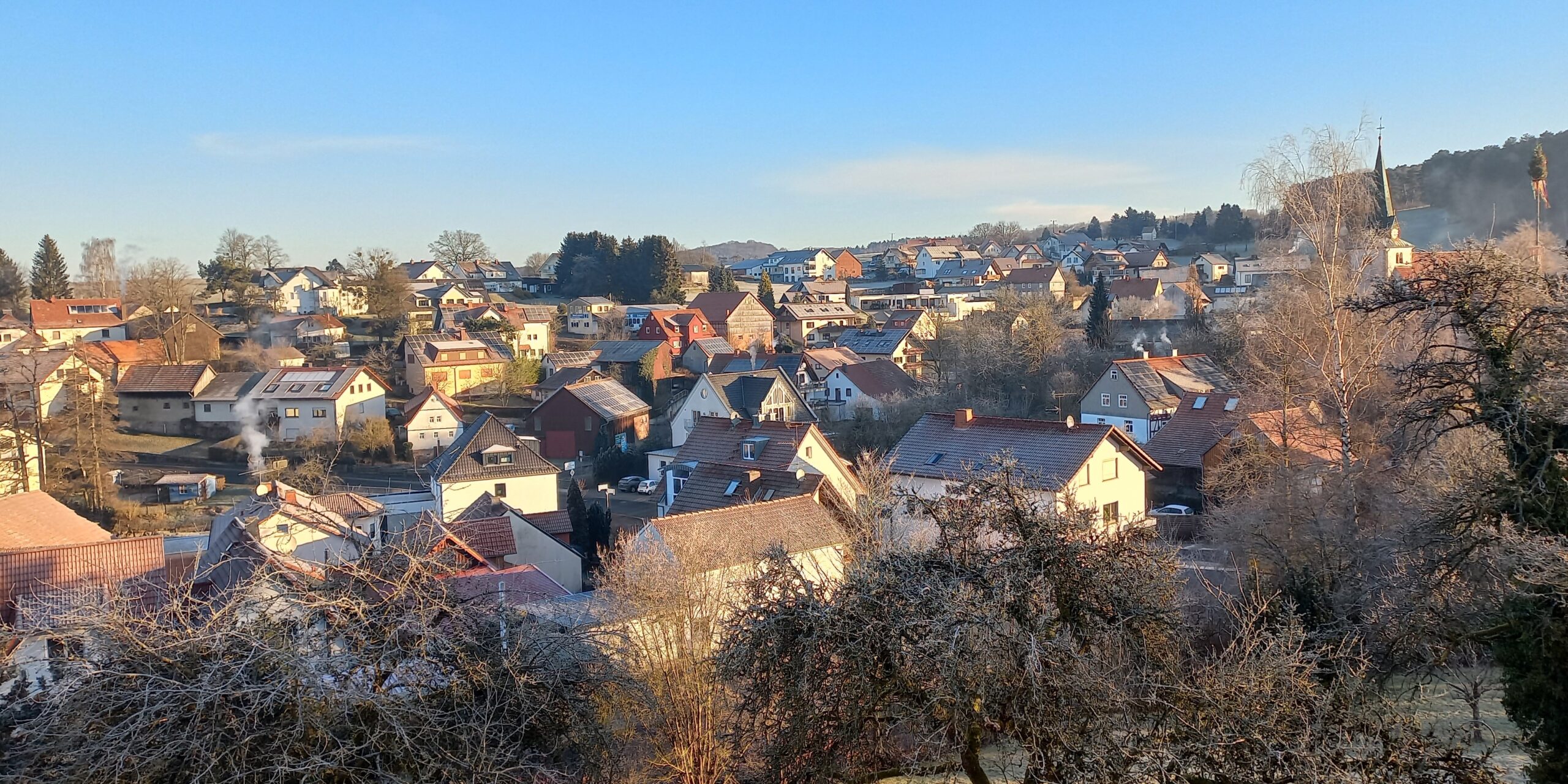
“This is an interesting coincidence:
the 90th anniversary of
the Sisters of Mary in Dietershausen and
the motto for the Holy Year “Pilgrims of Hope,”
said a participant at the meeting day on January 26, 2025 at the Schoenstatt Center in Dietershausen, Diocese of Fulda.
How much both events, 90 years since the first arrival of the Sisters of Mary in Dietershausen and the Holy Year proclaimed by Pope Francis with the motto “Pilgrims of Hope” have in common, quickly becomes apparent to the approximately 70 participants of the meeting day.
After the welcoming words of Eva-Maria Eckart, Sister M. Ilga Dreier, who is responsible for the southern German Sisters’ Province, and who herself lived and worked for many years on the Marienhöhe in Dietershausen, takes us all on the pilgrimage of a 90-year history.
“Telling one’s own story means praising God and thanking Him for all His gifts.”
These words of Pope Francis are, so to speak, the pilgrimage guide through the nine decades in which the Sisters of Mary have been in Dietershausen.
When the first three sisters came to Dietershausen, in February of 1935, at the request of the pastor in charge, no one had any idea what this joint pilgrimage – with all its ups and downs – would look like.
Some milestones on this pilgrimage:
- In 1957, the shrine in Dietershausen was consecrated.
- Father Kentenich visited the Marienhöhe in 1946 and 1967, and in 1967 he spoke about the importance of the shrine due to its proximity to the inner-German border.
- From 1969 to 1973, the Provincial House of the Sisters of Mary was built, in which all major events of the Schoenstatt Movement took place in the following years, including the annual “Feast of Faith” for young people from the Diocese of Fulda.
- From 1975 onwards, a special train with pilgrims travels from Fulda to Schoenstatt every year. In 2000, the main organizer of the pilgrimage, Sr. M. Luzia, was presented with a certificate by Auxiliary Bishop Schick. Among the pilgrims there is always a large crowd of usually over 100 First Communion children.
- The “German Autumn,” in the months of September and October 1977, shook the entire country due to the attacks of the RAF (Red Army Faction) and is considered one of the most serious crises in the history of the Federal Republic of Germany. As a reaction to the general helplessness in this situation, the Victory Column with the image of the Blessed Mother is erected on the grounds of the Provincial House. The concern for the reunification of Germany is also linked to this. For example, the Marian Column is deliberately built higher than the Berlin Wall. Mary is supposed to prove herself powerful. That is the request.
- In November 1989, the Berlin Wall falls and in the following days the first Schoenstatters from the former GDR, also known as East Germany, come to the Marienhöhe.
- In 1997, the very first pilgrimage shrine for Germany was set out in the shrine in Dietershausen.
- In the years that followed, the aged structure and the low number of vocations showed that the community of the Sisters of Mary in Germany was facing a significant restructuring process. As a result, the provincial house in Dietershausen would be sold to Caritas Fulda in 2015.
- On September 15, 2018, representatives of the Schoenstatt Family in the Diocese of Fulda deliberately bring the construction plans for a conversion of the Joseph Engling House to the place where Father Kentenich died and was buried in the Holy Trinity Church on Mount Schoenstatt, Vallendar.
With the reconstruction and redesign of the Josef Engling House as a spiritual center in the Diocese of Fulda, a new fruitful era has begun for the Schoenstatt Movement and beyond.
Looking back this afternoon, it becomes very clear that the roots of this new beginning lie in a decades-long blessed and eventful history.
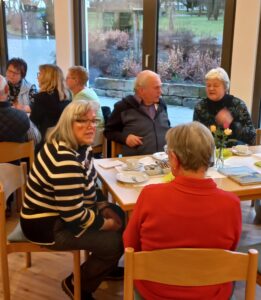
“In 90 years we have experienced ups and downs, beautiful and difficult,” said Sr. M. Ilga Dreier, “but looking back we can say: The confidence in a good and promising future and the victorious trust in the Blessed Mother in the Covenant of Love have always remained our companions, so that we can say with the motto of this year’s Holy Year:
“We are and will remain pilgrims of hope!”
As with any pilgrimage, a soothing and refreshing rest is needed on this day after the intense and interesting impressions. So, you can fortify yourself with coffee and cake and get into conversation with each other.
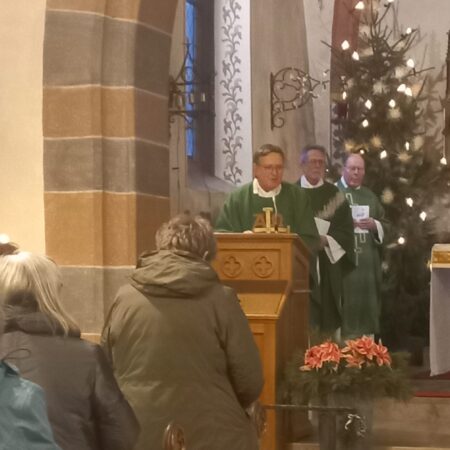
The conclusion of the day of encounter is the joint service in the parish church in Dietershausen, where Father Stefan Buß, Schoenstatt priest and pastor of the parish of Fulda, emphasized the importance of the
Schoenstatt Center as a spiritual center
for the Church of the future
and refers in particular to the presence of the Sisters of Mary when he says:
“What would a new, great house be if there was no one there who welcomed you warmly and joyfully.
The two simply belong together: places that let us experience home and faith, and people who make this possible.
